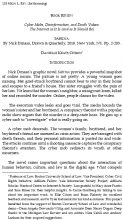Nick Drnaso’s graphic novel Sabrina provides a powerful snapshot of online norms. The picture is not pretty. A young woman goes missing. Her grief-struck boyfriend cannot bear to stay in their home and escapes to a friend’s house. Her sister struggles with the pain of her loss. We learn that the woman’s neighbor, a misogynist loner, killed her and recorded the murder. Online, people clamor for the video. The execution video leaks and goes viral. The media hounds the woman’s sister and her boyfriend. A conspiracy theorist with a popular radio show argues that the murder is a deep-state hoax. He gins up a cyber mob to “investigate” what is really going on. A cyber mob descends. The woman’s family, boyfriend, and her boyfriend’s friend are smeared as crisis actors. They are barraged with death threats, and their personal information is posted far and wide. The attacks continue until a shooting massacre captures the conspiracy theorist’s attention. The cyber mob redirects its wrath at other mourners. The novel raises important questions about the interaction of human behavior, culture, and law in the digital age. What compels people to like, click, and share grotesque execution videos, conspiracy theories, and destructive falsehoods? We have always been drawn to information that resonates with us, but the online environment seems to supercharge human biases. Why? Platforms structure and shape online activity, so what are they doing about online abuse? Each and every one of us is ultimately responsible for liking, clicking, and sharing the destruction. How can we work to change our behavior?
